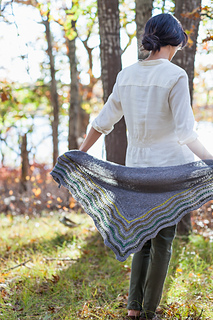patterns > Brooklyn Tweed >  Brooklyn Tweed: Winter 2014 and 1 more...
Brooklyn Tweed: Winter 2014 and 1 more...
> Kelpie






Kelpie
Save $1 when you purchase this pattern on BrooklynTweed.com, where you’ll find our knitting resource pages, video tutorials, and pattern support portal. All patterns purchased on our website can be added to your Ravelry library. Join our crafting community: sign up for our newsletter for the latest in Brooklyn Tweed yarns and patterns, knitting tips, subscriber exclusives, and even more woolly goodness!
“The traditional Shetland Hap shawl is a genre that I gravitate to time and again in my design work. I find it to be such a great combination of beauty & utility, while providing a comforting and interesting knitting experience. For this variation I wanted to modernize the look by creating an interesting, non-traditional construction, playing with tonal color variations, and adding bands of elongated stitches into the traditional shale border motif. While traditional haps are square in format, this version is triangular to match the more commonly-created style of our present day knitting culture.” – Jared Flood
CONSTRUCTION
- Shawl begins with a central garter stitch triangle, which begins at the lower point with a single stitch. When working triangle, yarn overs are worked at the beginning of every row to shape it towards the wider upper edge of shawl.
- After center triangle is complete, stitches are left live at the upper edge and held as Striped Shale Border is worked.
- Striped Shale Border is picked up from diagonal sides of center triangle (from the yarn overs worked during construction of the center triangle). One stitch is picked up in every selvedge yarn over from side edges. The border is worked from these picked- up stitches. After completion, the border is bound off very loosely to maintain elasticity.
- The top edging is worked from stitches picked up along the sides of the Striped Shale Border, and held live stitches from the center triangle. The top edging is worked with a band of eyelets and a few ridges of garter stitch before being bound off.
MATERIALS
Version I (photographed):
Fingering weight wool yarn in the following approximate amounts:
665 yards Color 1 (C1); 15 yards each of Colors 2 and 3 (C2 & C3); 20 yards each of Colors 4 and 5 (C4 & C5); 30 yards of Color 6 (C6)
Brooklyn Tweed Loft (100% American Targhee-Columbia wool; 275 yards/50g): 3 skeins C1; 1 skein each (or an oddment each) of C2, C3, C4, C5 & C6
Photographed in colors Stormcloud (C1), Sap (C2), Fauna (C3), Tent (C4), Button Jar (C5), and Artifact (C6)
Version II (alternate 2-color version):
Fingering weight wool yarn in the following approximate amounts:
665 yards Color 1 (C1); 100 yards of Color 2 (C2)
Brooklyn Tweed Loft (100% American Targhee-Columbia wool; 275 yards/50g): 3 skeins C1; 1 skein C2
GAUGE
19 stitches & 38 rows (19 ridges) = 4” in garter stitch; after moderate blocking
Note: Stretch swatch during blocking by 8–10%; allow to dry completely and rest for at least 12 hours before measuring.
NEEDLES
One 32” circular needle in size needed to obtain gauge listed
Suggested Size: 4 mm (US 6)
FINISHED DIMENSIONS
57” wingspan; 28½“ height at center spine
Measurements taken from relaxed fabric after blocking
SKILL LEVEL
3 of 5
Please note: the stitch patterns in this garment are charted only.

21597 projects
stashed
20349 times
469 projects
stashed
681 times
253 projects
stashed
216 times
- First published: January 2014
- Page created: January 7, 2014
- Last updated: August 5, 2024 …
- visits in the last 24 hours
- visitors right now




